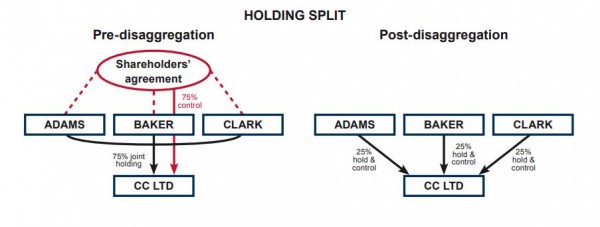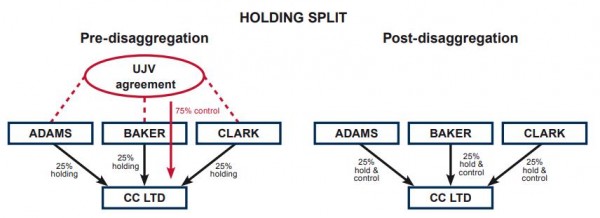Disaggregation of holding or control
Published 1 October 2016
Introduction
The fundamental rule of the Takeovers Code, rule 6, prohibits a person who holds or controls less than 20% of the voting rights in a Code company from increasing their voting control if that person (together with their associates) would hold or control more than 20% of the company’s voting rights after the increase. Although it may seem counter-intuitive, the Code’s fundamental rule may also apply to disaggregation of holding or control of voting rights in Code companies.
The Panel has granted some exemptions in respect of associated joint holders of voting rights splitting their joint holding into separate, individually owned parcels of shares (“holding splits”) (e.g. the Takeovers Code (Z Energy Limited) Exemption Notice 2013, which fell within the Panel’s exemption policy on IPO relief). Other examples include exemptions for matrimonial splits and some reconstructions of trusts. An exemption may also be granted in respect of a “control split” (even if there is no corresponding holding split). However, the Panel may not always grant exemptions; shareholder approval may be required under rule 7(c) of the Code before a disaggregation could become effective.
Treating “hold” and “control” the same when disaggregating ownership
It is clear that the Code regulates changes of control (as distinct from holding) of voting rights in Code companies (see the Panel’s Guidance Note on Control and Association).
A transaction involving shares in a Code company (such as an allotment of new shares or an acquisition of an existing parcel) will ordinarily make it clear when there has been a change in the holding of voting rights. It can be less clear when a change of control has occurred, as the control may be achieved through contractual arrangements (such as a joint venture agreement) rather than a joint shareholding.
It may be likely that joint holders (and joint controllers) are associates for the purposes of the Code, as a result of their ownership relationship or business relationship. “Associate” covers related companies, persons who act jointly or in concert or who follow one another’s wishes, as well as persons with business or personal relationships, and is defined in rule 4 of the Code. Accordingly, when determining their respective control percentages for the purposes of complying with the Code, associated joint holders (and joint controllers) will each need to take into account the holding or control of Code company voting rights of the other.
The Panel will not only consider the legal form of a disaggregation. It will also consider conduct after a disaggregation, to assess whether persons remain, or become, associates, following a split of joint holding or control, as part of its ongoing monitoring of compliance with the Code.
The discussion below sets out the Panel’s reasoning as to why control splits are likely to be treated by the Panel in the same fashion as holding splits.
In this guidance, “holding split” means any transaction in which:
(a) two or more persons jointly hold and control Code company voting rights; and
(b) those persons disaggregate their joint holding and control, and instead each individually hold and control a proportion of those voting rights.
A holding split will result in a transfer of all of the voting securities from the persons as joint holders to the persons individually, to hold on their own account, with each acquiring a portion of the formerly jointly-owned voting securities. In this guidance, “control split” means any transaction in which:
(c) two or more persons either separately or together hold, but in any case jointly control, voting rights in a Code company; and
(d) those persons disaggregate their joint control and instead each directly control a proportion of those voting rights, with no change to the holder of the voting rights.
Here there will be no transfer of any voting securities. It is the contractual arrangements between the persons that change. The impact under the Code is that the relevant parcel of Code company shares will now be voted as if they were separate parcels instead of being voted, under the joint venture arrangements, as a single block of shares.
These two scenarios are illustrated separately below.
Fact scenario – holding split (the “Holding Scenario”)
Adams, Baker, and Clark are joint holders of 75% of the voting rights in Code Company Limited (“CC Ltd”), a Code company. They achieved this joint shareholding through a Code-regulated transaction – e.g., a full takeover offer that did not reach the 90% threshold for compulsorily acquiring the rest of the shares.
Adams, Baker and Clark are parties to a shareholders’ agreement whereby they have agreed that the 75% parcel of CC Ltd shares will be voted by consensus or, if they cannot agree, then by a majority decision.
Adams, Baker and Clark want to end their shareholders’ agreement and disaggregate their joint holding in CC Ltd. Following the disaggregation, Adams, Baker and Clark will each hold 25% of the voting rights in CC Ltd. They will achieve this through a transfer of their jointly-held parcel of 75% of CC Ltd’s shares, in three equal parcels, to be acquired by each of Adams, Baker and Clark.
Prior to the disaggregation, Adams, Baker and Clark each individually hold 0% of the voting rights in CC Ltd, but together they all hold and control 75% of the voting rights in CC Ltd, both as joint shareholders on CC Ltd’s share register and through the shareholders’ agreement.
Following the disaggregation, Adams, Baker and Clark will each individually hold 25% of the voting rights in CC Ltd. They will each control 25% of the voting rights in CC Ltd, instead of jointly controlling 75%. This is depicted below.

Fact scenario – control split (the “Control Scenario”)
Adams, Baker and Clark each hold 25% of the voting rights in CC Ltd. They are parties to an unincorporated joint venture agreement (a “UJV”) whereby they have agreed to jointly control their separately-held voting rights, so that the 75% aggregate holding is always voted as a block. None of them has control over their own parcel of CC Ltd shares. They must always act together under the terms of the UJV. The UJV was put in place as an offer ‘vehicle’ under which a full takeover offer had been made, but the offer did not reach 90% acceptances, and so they were not able to compulsorily acquire the outstanding shares.
Adams, Baker and Clark want to end the UJV and disaggregate their joint control of voting rights in CC Ltd. Following the disaggregation, Adams, Baker and Clark will each individually control (as well as hold) 25% of the voting rights in CC Ltd. This is depicted below.
Prior to the disaggregation, Adams, Baker and Clark each individually hold 25% of the voting rights in CC Ltd. They each individually control 0% of the voting rights in CC Ltd, but together they jointly control 75% of the voting rights.

Application of the Code
Rule 6(1) of the Code states:
Except as provided in rule 7, a person who holds or controls—
(a) no voting rights, or less than 20% of the voting rights, in a Code company may not become the holder or controller of an increased percentage of the voting rights in the Code company unless, after that event, that person and that person’s associates hold or control in total not more than 20% of the voting rights in the Code company:
(b) 20% or more of the voting rights in a Code company may not become the holder or controller of an increased percentage of the voting rights in the Code company.
In the Holding Scenario, each of Adams, Baker and Clark will become the holder of an increased percentage of voting rights in CC Ltd as a result of the disaggregation, increasing from 0% to 25%, and so they either need to comply with rule 7 of the Code (e.g., by obtaining the approval of CC Ltd’s non-associated shareholders for their respective increases) or obtain an exemption from compliance with the Code; otherwise they would breach rule 6(1).
In the Control Scenario, there is no change in holding. Adams, Baker and Clark’s joint control of 75% of the CC Ltd voting rights is reduced to 0% as a result of the disaggregation. However, each of them will become the individual controller of an increased percentage of the voting rights in CC Ltd, increasing from 0% individual control to 25%.[1]
What is the impact of rule 6(2)?
Rule 6(2) of the Code is an anti-avoidance rule. It prevents the joining up of blocks of Code company voting rights above the 20% threshold in rule 6(1). Rule 6(2) states:
For the purposes of subclause (1), if—
(i) a person and any other person or persons acting jointly or in concert together become the holders or controllers of voting rights, that person is deemed to have become the holder or controller of those voting rights:
(ii) a person or persons together hold or control voting rights and another person joins that person or all or any of those persons in the holding or controlling of those voting rights as associates, the other person is deemed to have become the holder or controller of those voting rights:
(iii) voting rights are held or controlled by a person together with associates, any increase in the extent to which that person shares in the holding or controlling of those voting rights with associates is deemed to be an increase in the percentage of the voting rights held or controlled by that person.
Rule 6(2) is likely to always be relevant to a holding split and a control split because the parties will likely be acting jointly or in concert and be associates of each other.
It has been suggested (the “Deeming Rule Approach”) that rule 6(2) of the Code effectively overrides rule 6(1) in respect of a control split; A suggestion that the Panel rejects. The argument runs as follows:
(a) persons acting together to undertake a rule 7 Code-regulated transaction are associates acting jointly or in concert under rule 6(2(a);
(b) rule 6(2)(a) deems persons acting jointly or in concert who become the holders or controllers of voting rights to have become the holder or controller of all of the voting rights jointly held or controlled;
(c) a control split by the parties would reduce each person’s control of voting rights in the Code company, and so there is no requirement to comply with the Code (or to obtain an exemption from the Code) when undertaking a control split.
Applying the Deeming Rule Approach to the Control Scenario:
(a) Adams, Baker and Clark acted jointly or in concert when undertaking their takeover offer;
(b) Adams, Baker and Clark are each deemed by rule 6(2)(a) to be the controller of 75% of the voting rights in CC Ltd;
(c) following the control split, each of Adams, Baker and Clark will have reduced his or her control of voting rights in CC Ltd from 75% to 25%. Because none of Adams, Baker or Clark will have become the holder or controller of an increased percentage of voting rights in CC Ltd, there is no requirement to comply with the Code or to obtain an exemption for the control split.
Rule 6(2) is an anti-avoidance provision. The purpose of the provision is to prevent transactions that would increase the control percentage a person has in Code company voting rights from occurring outside of a rule 7 mechanism. Rule 6(2) operates only as an anti-avoidance provision. In the Panel’s view, rule 6(2) does not operate to sanction a later disaggregation of control without rule 6(1) applying to that disaggregation.
Potential Mischief
The Deeming Rule Approach is contrary to the anti-avoidance purpose of rule 6(2) and would allow rule 6(2) to be used to circumvent the Code, as demonstrated in the following scenario.
Adams, Baker and Clark each hold 25% of the voting rights in CC Ltd, and are parties to a UJV whereby they have agreed that Clark will be the sole decision-maker in respect of voting the entire 75% parcel of CC Ltd voting rights. The UJV was in place as an offer ‘vehicle’ under which a full takeover offer had been made, but the offer did not reach 90% acceptances so they were not able to compulsorily acquire the outstanding shares.
Adams, Baker, and Clark want to end the UJV and disaggregate their control. Following the disaggregation, Adams, Baker and Clark will each hold and control 25% of the voting rights in CC Ltd.
According to the Deeming Rule Approach, each has reduced their control in CC Ltd and so there is no requirement to comply with the Code or to obtain an exemption for the control split.
Subsequent to the control split, Adams, Baker and Clark each control 25% of the voting rights in CC Ltd. While Clark has in fact reduced his control of CC Ltd voting rights from 75% to 25%, each of Adams and Baker have in fact effectively increased their control of CC Ltd voting rights from 0% to 25% without Code regulation.
The Panel’s approach
The Panel’s clear approach in the past has been that rule 6(2)(a) deems those jointly increasing their holding or control of voting rights to have each become the holder or controller of those voting rights only for the purposes of that increase. When a person’s holding of voting rights subsequently changes by way of a holding split, they are considered to have increased from a starting position of 0%. The same is true in respect of a control split.
Conclusion
Regulation of changes in control of voting rights in Code companies can be even more important than regulating changes in holding. A change of holding without a simultaneous change of control has no real effect on shareholders (for example, the use of a bare trustee to hold a person’s shares has no real effect on control, because the trustee must act in accordance with the beneficiary’s instructions). However, a change of control with no corresponding change of holding may have significant repercussions for the direction of the company.
Given that control of voting rights can have a much greater impact on shareholders in Code companies than holding, it would be inconsistent with the objectives of the Code to require shareholder approval (or an exemption) for holding splits (even without a corresponding change in control) while simultaneously allowing any control split to occur without the Code applying.
As such, the Panel considers that control splits should be regulated by the Code, just as holding splits are. When two or more persons acting jointly or in concert together become the holders or controllers of voting rights without utilising a rule 7 mechanism, rule 6(2)(a) will deem each of those persons to have become the controller of those voting rights. However, if a control split subsequently results in each person individually controlling voting rights where formerly the control was joint, that person will be considered to have increased from a starting position of 0%, and either Code compliance or an exemption will be required.
Footnotes:
[1] It may make no difference to the application of the Code whether the split is proportionate or not. Even if Adams were to have 1% of the CC Ltd shares transferred to her, and Baker and Clark were to have 19% and 55% respectively, all need to comply with the Code (or with an exemption from the Code) if they are associates of each other because each of them, together with their associates, would be above the Code’s 20% threshold.



